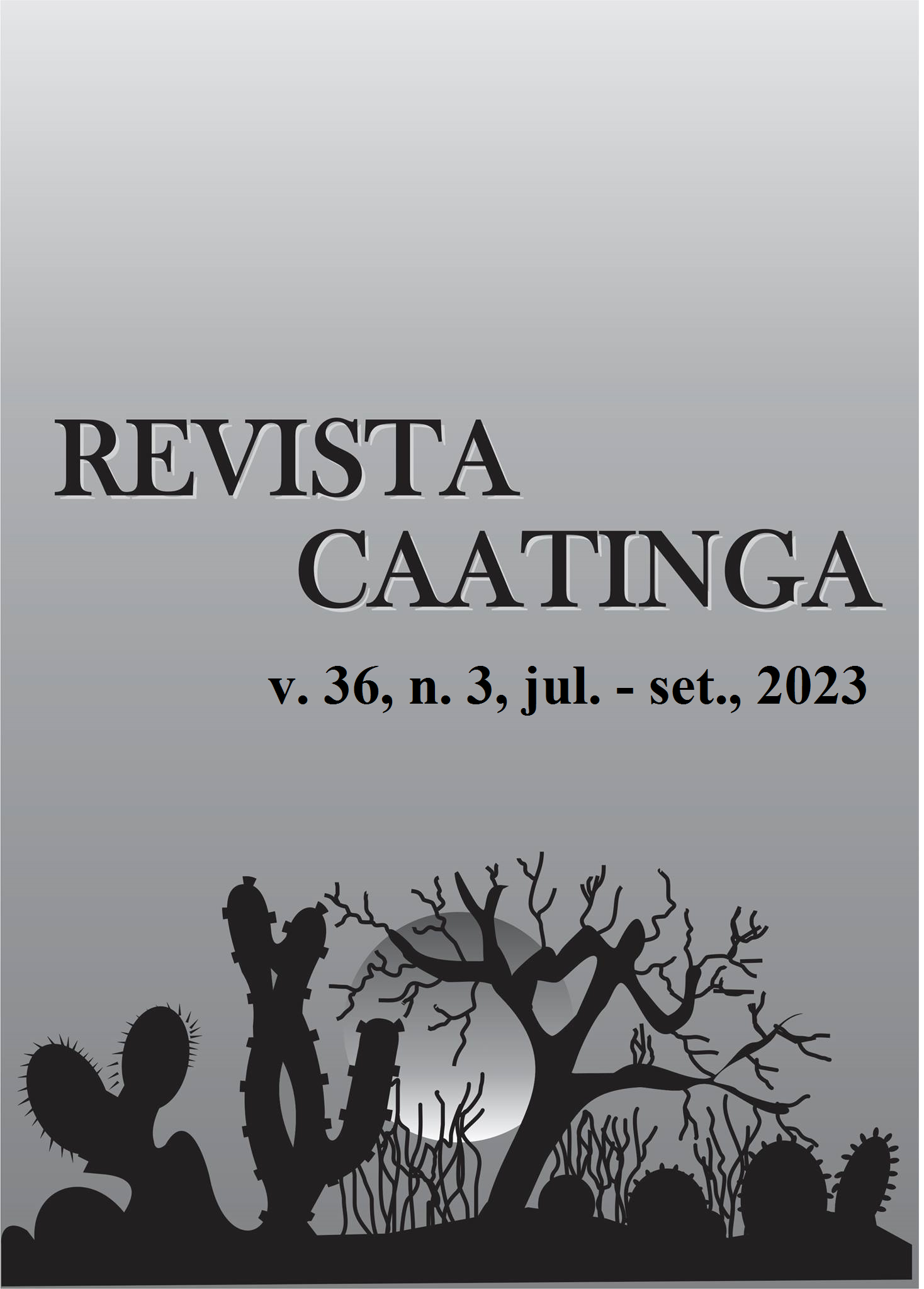Spatial variability of water electrical conductivity in underground dam areas in the semi-arid region of Rio Grande do Norte, Brazil
DOI:
https://doi.org/10.1590/1983-21252023v36n317rcKeywords:
Alluvial aquifer. Salinity. Geostatistics. Interpolation.Abstract
Underground dams have been widely deployed in the semi-arid region of Rio Grande do Norte, a state in the Brazilian Northeast, aiming to mitigate the effects caused by water scarcity. In this study, the geographic distribution of the electrical conductivity of water of underground dams was evaluated at the end of the dry season of 2018 and at the end of the rainy season of 2019. Maps were created in ArcGIS 10.4.1 software using the Inverse Distance Weighted interpolator. The results indicated high electrical conductivity variability in the evaluated underground dams. The highest values were obtained in the eastern portion of the Rio Grande do Norte state, except for two dams, located in the municipalities of Apodi and Severiano Melo. In most of the underground dams (64%), the water has an electrical conductivity with low soil salinization potential (EC < 0.7 dS m-1). It was observed that the salinity of the underground dams is influenced by several factors, such as climate, relief, land use and occupation due to rural agglomerations and animal husbandry in the dam hydrographic basin, and intensive nutritional management with fertilizers in the dam area.
Downloads
References
AHMED, M. F. et al. Groundwater dams, general characteristics and historical development. Journal of Faculty of Engineering & Technology, 23: 121-129, 2016.
ALMEIDA, O. A. Qualidade da água de irrigação. 1. ed. Cruz das Almas, BA: Embrapa Mandioca e Fruticultura, 2010. 234 p.
ANA – Agência Nacional de Águas. Base Hidrográfica Ottocodificada Multiescalas. 2012. Disponível em: <http://dadosabertos.ana.gov.br/datasets/b78ea64219b9498c8125cdef
b7_0>. Acesso em: 20 nov. 2019.
ANDRADE, T. S. et. al. Variabilidade espaço-temporal da condutividade elétrica da água subterrânea na região semiárida de Pernambuco. Revista Brasileira de Engenharia Agrícola e Ambiental, 16: 496–504, 2012.
CIRILO, J. A. et al. Soluções para o Suprimento de Água de Comunidades Rurais Difusas no Semi-Árido Brasileiro: Avaliação de Barragens Subterrâneas. Revista Brasileira de Recursos Hídricos, 8: 5-24, 2003.
COSTA, A. M. B.; MELO, J. G.; SILVA, F. M. Aspectos da salinização das águas do aqüífero cristalino no estado do Rio Grande do Norte, Nordeste do Brasil. Águas Subterrâneas, 20: 67-82, 2006.
DUBREUIL, V. et al. Os tipos de climas anuais no Brasil: uma aplicação da classificação de Köppen de 1961 a 2015. Revista Franco-Brasilera de Geografia, 37: 1-20. 2018.
EMBRAPA - Empresa Brasileira de Pesquisa Agropecuária. Mapa de Solos do Brasil. 2020. Disponível em: <http://geoinfo.cnps.embrapa.br/layers/geonode%3Abrasil_solos_5m
_20201104>. Acesso em: 14 jan. 2021.
FRANÇA, F. M. C.; PINHEIRO, J. C. V.; CARVALHO, R. M. Barragem subterrânea no Semiárido do Ceará: caracterização e análise da viabilidade econômica. Parcerias Estratégicas / Centro de Gestão e Estudos Estratégicos, 21: 17-44, 2016.
FUNASA - Fundação Nacional de Saúde. Manual de saneamento. 5. ed. Brasília, DF: Funasa, 2019. 545 p.
HELENA, B. A. et al. Temporal evolution of groundwater composition in an alluvial aquifer (Pisuerga river, Spain) by principal component analysis. Water Research, 34: 807-816, 2000.
HELENA, B. A. et al. A case of hydrochemical characterization of an alluvial aquifer influenced by human activities. Water, Air, and Soil Pollution, 112: 365–387, 1999.
LIMA, A. O. et al. Variation of the water table and salinity in alluvial aquifers of underground dams in the semi-arid region of Rio Grande do Norte, Brazil. Bioscience Journal, 35: 477-484, 2019.
LIMA, A. O. et al. Barragens subterrâneas no semiárido brasileiro: análise histórica e metodologias de construção. Irriga, 18: 200-211, 2013.
LIMA, A. O. et al. GPR 3D profile of the adequateness of underground dams in a sub-watershed of the brazilian semiarid. Revista Caatinga, 31: 523-531, 2018.
LIMA, A. O. et al. Concentration of Traces Metals in Underground Dams in the Semi-Arid of the Rio Grande do Norte State, Brazil: Case Study of the Sub-Basin of the Cobras River. Water, Air and Soil Oollution, 231: 1-9, 2020.
LIMA, A. O. Nova abordagem metodológica para locação, modelagem 3D e monitoramento de barragens subterrâneas no semiárido brasileiro. 2013. 243 f. Tese (Doutorado em Geodinâmica e Geofísica) – Universidade Federal do Rio Grande do Norte, Natal, 2013.
RABEMANANA, V. et al. Origin of the high variability of water mineral content in the bedrock aquifers of Southern Madagascar. Journal of Hydrology, 310: 143-156, 2005.
SANTOS, H. G. et al. Sistema Brasileiro de Classificação de Solos. 5. ed. rev. e ampl. Brasília, DF: Embrapa, 2018. 356 p.
SOUZA, G. S. et al. Krigagem ordinária e inverso do quadrado da distância aplicados na espacialização de atributos químicos de um argissolo. Scientia Agraria, 11: 73-81, 2010.
STEVANOVIC, Z. Subsurface Dams as a Solution for Supplementary Recharge and Groundwater Storage in Karst Aquifers in Arid Areas. In: LOLLINO, G. et al. (Eds.). Engineering Geology for Society and Territory. Springer, 2015. v. 5, cap. 90, p. 471-474.
Downloads
Published
Issue
Section
License
Os Autores que publicam na Revista Caatinga concordam com os seguintes termos:
a) Os Autores mantêm os direitos autorais e concedem à revista o direito de primeira publicação, com o trabalho simultaneamente licenciado sob a Licença Creative Commons do tipo atribuição CC-BY, para todo o conteúdo do periódico, exceto onde estiver identificado, que permite o compartilhamento do trabalho com reconhecimento da autoria e publicação inicial nesta revista, sem fins comerciais.
b) Os Autores têm autorização para distribuição não-exclusiva da versão do trabalho publicada nesta revista (ex.: publicar em repositório institucional ou como capítulo de livro), com reconhecimento de autoria e publicação inicial nesta revista.
c) Os Autores têm permissão e são estimulados a publicar e distribuir seu trabalho online (ex.: em repositórios institucionais ou na sua página pessoal) a qualquer ponto antes ou durante o processo editorial, já que isso pode gerar alterações produtivas, bem como aumentar o impacto e a citação do trabalho publicado (Veja O Efeito do Acesso Livre).







